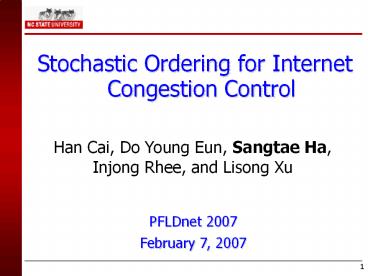Stochastic Ordering for Internet Congestion Control - PowerPoint PPT Presentation
1 / 19
Title:
Stochastic Ordering for Internet Congestion Control
Description:
Title: Z-MAC: a Hybrid MAC for Wireless Sensor Networks Last modified by: Jeong Ki Min Document presentation format: On-screen Show Other titles – PowerPoint PPT presentation
Number of Views:42
Avg rating:3.0/5.0
Title: Stochastic Ordering for Internet Congestion Control
1
- Stochastic Ordering for Internet Congestion
Control
Han Cai, Do Young Eun, Sangtae Ha, Injong Rhee,
and Lisong Xu
PFLDnet 2007 February 7, 2007
2
High-Speed TCP Variants
- Many High-speed TCP variants have been proposed
- High-speed protocols can be divided into three
categories
- Can we compare loss-based protocols?
3
Example of Growth Functions
Window Size
Time
4
First Order vs. Second or High Order Behaviors
First order analysis
Second or high-order analysis
Stability decision answer for the question
which one is better
Stability binary decision whether it
converges to its fixed point
Fairness by comparing expected throughput
between two protocols
Fluctuations of rates
Variation of window sizes
- If two protocols have the same average behaviors,
they are not distinguishable by the first order
analysis (fixed point analysis) - Even if two protocols have the same first order
behaviors (expected throughput), they could have
widely different second or high-order behaviors.
5
CoV one example of second order
CoV (0.13)
CoV (0.21)
BIC (utilization 94)
HTCP (utilization 82)
- CoV, standard deviation over mean, is commonly
used by practitioners to compare the stability of
protocols. - Higher CoV also affects the general well beings
of the network including utilization, queue
oscillation, packet loss characteristics
6
Stochastic Convex Orderingtheoretical tool to
analyze the 2nd order.
Definition for random variables, X and Y,
X
Y
Ef(X)
Ef(Y)
means
cx
for any convex function f, e.g, f variance.
- If X ?cx Y in convex ordering, it means X is
less variable than Y.
7
Main Assumption
Assumption The Inter-loss intervals Tn are
i.i.d (independent and identically distributed)
commonly observed by many Internet measurement
studies 4,5,6.
4 Y. Zhang, N. Duffield, V. Paxson, and S.
Shenker, On the constancy of Internet path
properties, ACM SIGCOMM IMW 2001 5 E. Altman,
K. Avrachenkov, and C. Barakat, A Stochastic
Model of TCP/IP with Stationary Random Loss, ACM
SIGCOMM 2000 6 J. Padhye, V. Firoiu, D.
Towsley, and J. Kurose, Modeling TCP Throughput
a Simple Model and its Empirical Validation, ACM
SIGCOMM 1998
8
Main result
- Given window profiles f(t) and g(t), h(t)
f(t)/g(t) is monotonically decreasing, - then f(t) ?cx g(t).
- E.g.
Concave lt Convex
f(t) log(t)
g(t) t2
f(t) t0.5
g(t) t2
f(t) 0.5t2
g(t) 3t3
9
Results - Intuition
Stationary loss
Concave
Non-stationary loss
- During stationary loss, concave has less variance
because its windows are mostly around the mean so
that its variance is small. - During non-stationary loss, concave-convex has
also its windows - mostly around the mean.
10
NS2 Simulation varification
- Dumbbell, bottleneck 250Mbps, RTT 100ms,100 BDP
buffer size - Loss generated by predefined models and by using
background traffic - Background Traffic (20 of total link bandwidth)
- Type I (five long-lived flows), Type II (300 web
sessions) - Five pseudo protocols simulated
- Root, Linear, Power (Square), Exponential,
Concave-Convex - Measure the CoVs of window sizes of the five
pseudo protocols.
11
NS2 Simulation Result
- The result confirms the same ordering predicted
by our analytical result
Root
Linear
Power
Exponential
Concave-Convex
Exponential
Root
12
Testbed (Dummynet) Setup
400Mbps Bottleneck, Convex functions HSTCP
(Linear), HTCP (Power), and STCP
(Exponential) Concave-Convex functions CUBC and
BIC-TCP
Iperf long lived flows Surge web traffic
generator
RTT for background traffic is from recent
measurement study 7
7 J. Aikat, J. Kaur, F. D. Smith, and K.
Jeffay, Variability in TCP round-trip times, IMC
2003
13
CoV and Link Utilization
- Buffer size (1MB), four HS flows with the same
RTT (40ms 320ms)
14
Impact of buffer sizes
- Buffer size (1 8MB), four HS flows with the
same RTT (320ms)
15
Conclusion and Future Work
- Window growth function determines its relative
stability. - Stochastic Convex Ordering can be applicable to
loss-based protocols. - Concave-Convex protocols tends to give the
smallest rate variation (BIC, CUBIC). - Rate variations can affect the general
well-beings of the network including utilization,
queue oscillations and packet loss
characteristics. - Dynamics of aggregated flows and their impact on
the general health of the networks would be our
future work.
16
Q A
- More experimental results are available at
http//netsrv.csc.ncsu.edu/convex-ordering
Thank you for your participation
17
Backup Slides
- Backup Slides
18
NS2 Simulation Results (Loss Model)
19
Impact of congestion
- Buffer size (2MB), two HS flows with the same RTT
(40ms 320ms), a dozen long-lived TCP flows
added - Convex protocols have a large variations (convex
ordering still exists)

